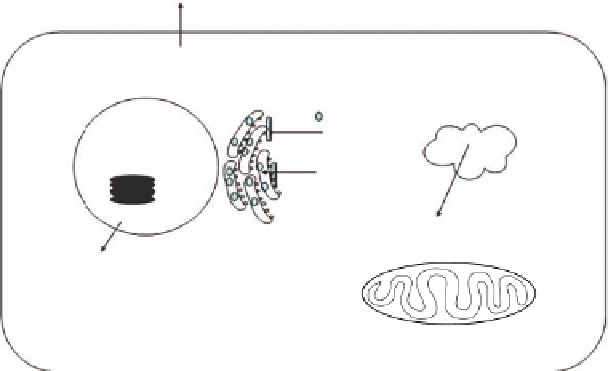Biomedical Engineering Reference
In-Depth Information
Pf´
MDR1
ER
Apicoplast
Ca
2+
FV
Hemozoin
Pf
ATP6
Terpenoids
Pf
CRT
Mitochondrion
Electron transport
FIGURE 21.6
Plasmodium
parasite: The Ca
2+
-ATPase (
Pf
ATP6) pumps Ca
2+
from the cytosol into the endo-
plasmic reticulum (ER) maintaining a low cytosolic Ca
2+
concentration and a high concentration inside the
ER. The single circle outside the ER represents the low cytosolic Ca
2+
concentration in contrast to the several
order of magnitudes higher ER concentration (many circles). Artemisinin and its analogs block this pump.
Blockage of the pump leads to a prolonged high cytosolic Ca
2+
concentration, which is lethal for the cell.
Hemozoin is accumulated inside the food vacuole (FV). Blockage of hemozoin formation by, e.g., chloroquine
is lethal to the cell. Terpenoids are formed in the apicoplasts by the nonmevalonate pathway. Blockage of this
pathway by, e.g., fosmidomycin is lethal to the cell.
De novo
pyrimidine synthesis includes reduction of dihy-
roorotate into orotate, a reaction that is dependent on the electron l ow in the mitochondria. Atovaquone blocks
the electron l ow. By removing chloroquine from the FV, the pump
Pf
CRT makes the parasite resistant toward
chloroquine. The pump
Pf
MDR1 removes a number of drugs from the cytosol and induces resistance.
the food vacuole of the parasite. The food vacuole is characterized by a pH between 5.0 and 5.5. The
parasites use at least three types of proteases for the catabolism of hemoglobin. Since nude heme is
toxic to all kind of cells the parasites have to detoxify it by converting it into an insoluble complex.
The heme detoxii cation process is concluded by precipitation of microcrystalline hemozoin
(
21.6
) (Figure 21.7), which by precipitation loses the effect on the biological system. The mecha-
nism of action behind a series of antimalarial drugs consists in blocking the formation of hemozoin
by association with hematin. Two criteria have to be fuli lled for drugs that act by preventing detoxi-
i cation of heme: (1) the drug must accumulate in the food vacuole of the parasite, and (2) the
drug must bind to hemozoin. For a drug to be active in the human patient, several other factors
including absorption, metabolism, and distribution need to be taken into account. Thus association
with hematin is a necessary, but not sufi cient requirement, for an antimalarial drug targeting the
hemazoin formation. Criterion 1 might be fuli lled by introduction of a basic aliphatic amine into
the molecule, thus taking advantage of the low pH of the food vacuole.
21.5.1.1 4-Aminoquinolines
The 4-aminoquinolines are characterized by the presence of an amino group in the 4-position of
the quinoline nucleus.
It is claimed that the drug, which with no comparison has saved most human lives, is chlo-
roquine (
21.7
) (Figure 21.8). For more than 40 years, chloroquine was the i rst-line therapeu-
tic and prophylactic agent for malaria. In the last three decades, however, chloroquine resistant
P. falciparum
and
P. vivax
strains have developed, but the drug is still believed to be efi cient
toward infections by
P. ovale
and
P. malariae
. The resonance interaction between the electron
pair of the exocyclic amino group and the quinoline nitrogen atom (Figure 21.8) will give the
protonated 4- and 2-aminoquinolines higher p
K
a
values (8.1 and 10.2) than other aminoquinolines.

